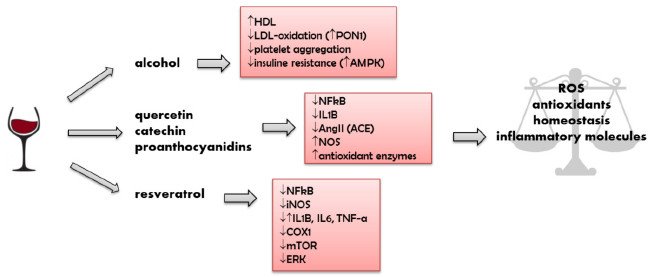Wine is one of the oldest traditional beverages in the world and consists of a complex set of compounds. In general, wine comprises water, ethanol, glycerol, higher alcohols and polysaccharides, organic acids, carbohydrates, polyphenols such as anthocyanins and tannins, minerals, volatile compounds, and other compounds. Of all the components of a wine, polyphenols play a crucial role in its quality and aroma, even though the amount of polyphenols is only 0.1%. Most importantly, polyphenols are the main phytochemicals associated with the beneficial properties of wine for human health. In addition, phenolic compounds such as flavanols, flavonols, flavanols, flavonoids, tannins, anthocyanins, hydroxycinnamic acid, hydroxybenzoic acid, and resveratrol may prevent the development of cardiovascular disease, cancer, diabetes, inflammation, and several other chronic diseases. The chemical composition of wine may vary depending on factors such as varietal, winemaking techniques, and aging. Detecting the chemical composition of a wine is essential to control the flavor, aroma, color, and structure of the wine.
 Fig.1. Red wine constituents and their action on biological mechanisms. (Markoski MM et al., 2016)
Fig.1. Red wine constituents and their action on biological mechanisms. (Markoski MM et al., 2016)
The flavor of wine comes from a balanced mixture of compounds of many different origins and structures. In addition, some compounds can be produced accidentally due to errors in the winemaking process, false additions, or improper storage. Some countries and regions have specified conditions that wines must meet in terms of origin, chemical composition, and treatments that have been applied. Wine chemical composition analysis is an important indicator to evaluate the quality of wine, especially the determination of the most beneficial components of wine for human health.
Lifeasible provides a one-stop platform for wine chemical composition analysis through a global network of state-of-the-art laboratories covering a wide range of liquor, beer, yellow wine, rice wine, prepared wine, food alcohol, etc. Our solution covers the whole process, from sample processing to data analysis, you only need to provide the original sample. During the testing process, our testers will strictly implement the international wine chemical composition testing standards and choose the appropriate testing standards for different wines to ensure credible and reasonable test results.
Our wine composition analysis solutions include:
| Wine Composition Analysis Items | Wine Composition Analysis Items Description | Wine Composition Analysis Methods |
| Principal Component Analysis in Wine | We provide powerful principal component analysis tools to help clients analyze the chemical and organoleptic characteristics of wines, identify patterns and relationships between variables, and classify wines according to their characteristics. |
|
| Detection of Unknowns in Wine | Unknowns in wine can come from various sources, such as contamination during the production process, accidental reactions between components, or the use of unauthorized additives. We offer advanced techniques to identify and quantify unknown substances to ensure your wine is safe and meets the required quality standards. | |
| Formulation Ratio Testing in Wine | Testing for wine formulation ratio is an important quality control measure to ensure that consumers get value for their money and maintain the integrity of the wine industry. We offer professional formulation ratio testing solutions to detect wines that have been intentionally or unintentionally diluted with water or other substances. | |
| Wine Extracts Analysis | Wine is composed of a complex array of compounds. We can analyze wine extracts for a variety of different components. We focus on analyzing polyphenols (e.g., resveratrol, quercetin, and catechins) and volatile compounds (e.g., esters, aldehydes, and ketones) in wine. | |
| Wine Off-Flavor Composition Analysis | Off-flavors in wine may be caused by various compounds, including volatile sulfur compounds, acetaldehyde, ethyl acetate, and botrytis yeast. We offer various analytical techniques to determine these odorants, including sensory analysis, gas chromatography (GC) and liquid chromatography (LC), etc. | |
| Wine Flavor Composition Analysis | There are many different flavor substances in wine, including volatile organic compounds, non-volatile organic compounds, and inorganic compounds. We combine gas chromatography (GC) or liquid chromatography (LC) with mass spectrometry (MS) detection to identify and quantify flavor compounds in wine samples. |
(1) Sample processing.
(2) Determination of wine composition.
(3) Generate test results.
(4) Data analysis and evaluation.
Lifeasible aims to conduct wine composition analysis in accordance with national and local standards. Our dedicated team provides customized solutions to ensure that our clients' needs are met. If you are interested in these services or solutions, please contact us to obtain the latest information.
Reference
Lifeasible has established a one-stop service platform for plants. In addition to obtaining customized solutions for plant genetic engineering, customers can also conduct follow-up analysis and research on plants through our analysis platform. The analytical services we provide include but are not limited to the following:
STU-CRISPR System Improves Plant Genome Editing Efficiency
April 19, 2024
Application of Exosomes in Facial Beauty
April 12, 2024